Celiac Disease in Women
Learning Objectives At the end of this presentation you should: 1-Enumerate the problems a woman affected with celiac disease may encounter during her life 2-Be aware of the methods of diagnosis of celiac disease 3-Describe effective control for the disease to minimize symptoms and long term sequelae of the disease
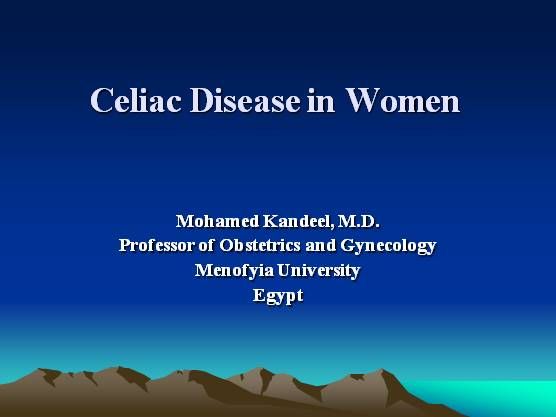
Mohamed Kandeel, M.D.
Professor of Obstetrics and Gynecology
Menofyia University Egypt

Learning Objectives
At the end of this presentation you should:
1-Enumerate the problems a woman affected with celiac disease may encounter during her life
2-Be aware of the methods of diagnosis of celiac disease
3-Describe effective control for the disease to minimize symptoms and long term sequelae of the disease
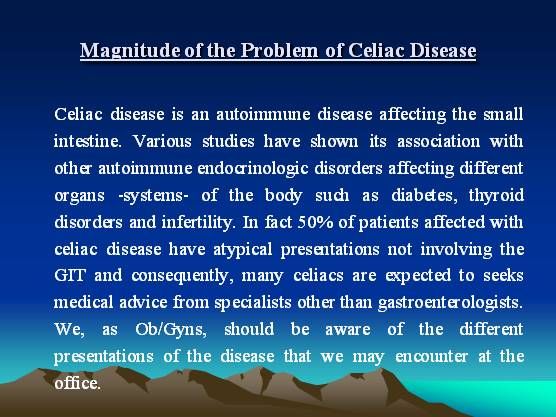
Magnitude of the Problem of Celiac Disease
Celiac disease is an autoimmune disease affecting the small intestine. Various studies have shown its association with other autoimmune endocrinologic disorders affecting different organs -systems- of the body such as diabetes, thyroid disorders and infertility. In fact 50% of patients affected with celiac disease have atypical presentations not involving the GIT and consequently, many celiacs are expected to seeks medical advice from specialists other than gastroenterologists. We, as Ob/Gyns, should be aware of the different presentations of the disease that we may encounter at the office.
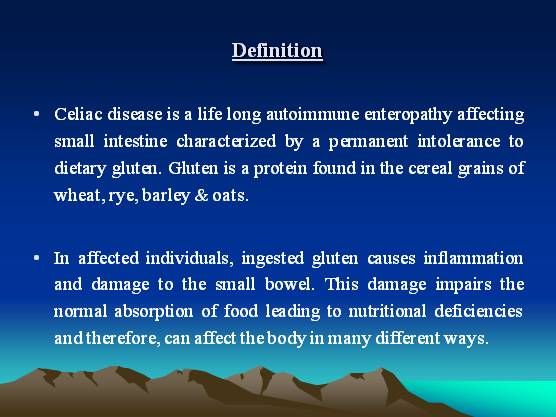
Definition
• Celiac disease is a life long autoimmune enteropathy affecting small intestine characterized by a permanent intolerance to dietary gluten. Gluten is a protein found in the cereal grains of wheat, rye, barley & oats.
• In affected individuals, ingested gluten causes inflammation and damage to the small bowel. This damage impairs the normal absorption of food leading to nutritional deficiencies and therefore, can affect the body in many different ways.

Incidence
The incidence of Celiac disease varies between 1-100 to 1-300 in the general population according to geographical distribution. Generally speaking, celiac disease is more common in women than men. This high incidence can be explained by the fact that women are more keen about their health compared to males and therefore, they seek early medical advise. The high incidence of the disease in women can be just a simple reflection of this behavior.

Incidence (Cont.)
The incidence of celiac disease varies among specific groups. It ranges between 4-8% among women diagnosed with unexplained infertility. About 6% of anemic women have undiagnosed celiac disease. A recent study suggested that 3-4% of women who have osteoporosis have celiac disease.

Effect on Menstruation
1- Amenorrhea is a possibility
2-Short fertile period: affected women have late menarche and early menopause

Effect on Pregnancy and Lactation
1-Iron deficiency anemia: due to:
a-Malabsorption of dietary iron
b-Occult blood loss from gastro-intestinal tract
2-Poor absorption of folic acid leading to recurrent miscarriages and increased theoretical risk of of neural tube defects in babies of affected mother
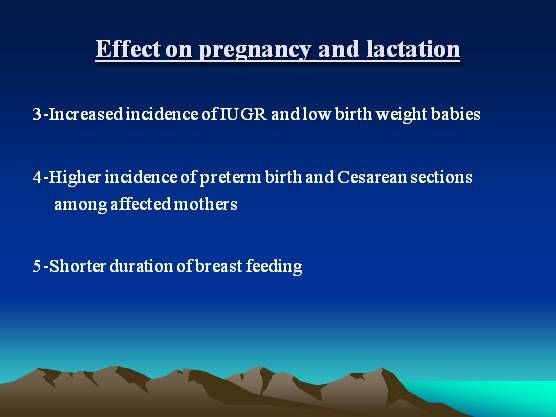
Effect on Pregnancy and Lactation
3-Increased incidence of IUGR and low birth weight babies
4-Higher incidence of preterm birth and Cesarean sections among affected mothers
5-Shorter duration of breast feeding

Effect on Fertility
1- Unexplained infertility
2-Recurrent miscarriages
3-Poor quality seminal fluid was detected in males affected with celiac disease
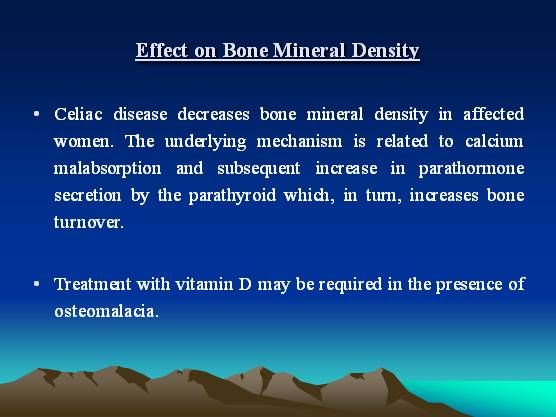
Effect on Bone Mineral Density
• Celiac disease decreases bone mineral density in affected women. The underlying mechanism is related to calcium malabsorption and subsequent increase in parathormone secretion by the parathyroid which, in turn, increases bone turnover.
• Treatment with vitamin D may be required in the presence of osteomalacia.
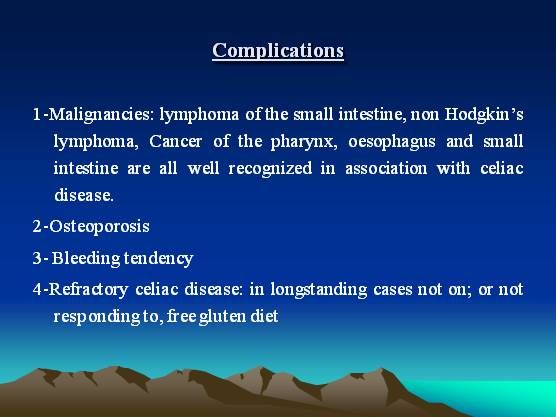
Complications
1-Malignancies: lymphoma of the small intestine, non Hodgkin’s lymphoma, Cancer of the pharynx, oesophagus and small intestine are all well recognized in association with celiac disease.
2-Osteoporosis
3- Bleeding tendency
4-Refractory celiac disease: in longstanding cases not on; or not responding to, free gluten diet

Diagnosis
I- Symptoms include:
50% of patients show the classic form of the disease of chronic diarrhoea, nausea, vomiting, flatulence, bloating, abdominal pain and weight loss. Fatigue, weakness and lethargy are also common associated symptoms.
Many affected adults lack GI symptoms & present with a wide spectrum of manifestations such as insulin-dependent diabetes, joint pains, osteoporosis, iron, folate, B12 deficiency, depression, dermatitis herpetiformis & infertility

Diagnosis (Cont.)
II-Serology:
Tests are used to measure antibodies formed against the breakdown products of ingested glutens and the enzymes that mediate the tissue damage in the disease. Because of their high sensitivity, they are used for screening. They also can be used to monitor response of patients on strict gluten diet
1-Antigliadin antibodies (AGA)
2-Anti-tissue antibodies (tTGA)
3-Antiendomysial antibodies (EMA)

Diagnosis (Cont.)
III-The gold standard diagnostic test is endoscopic biopsy of the upper small bowel. Because of the invasive nature of this, it should be reserved only for those with positive screening serology tests. However, A negative test may still prompt a biopsy if the clinical suspicion is high. 4-8 biopsies should be obtained for diagnosis from either the distal duodenum or the proximal jejunum.

Diagnosis (Cont.)
IV-Prothrombin time and partial thromboplastin time: useful to identify deficiency of vitamin K, which predisposes patients to hemorrhage
V-Radiology: has no role in the diagnosis of celiac disease. However, it can help rule out other pathologies of gastro-intestinal disease.

Treatment
1) The standard treatment is gluten free diet for life. It is essential to relieve symptoms and avoid long term complications of the disease. Avoid all foods made from wheat, rye, and barley.
Examples are:
Breads, cereals, pasta, cakes and cookies
Sausages, processed and canned meats
Yogurt, ketchup and mustard
Candy bars and ice cream

Treatment (Cont.)
2) Avoid medications and vitamin preparations which contain gluten.
3) Steroids or immunosuppressants in refractory cases
4) Supplemental iron, folate, B12, calcium and magnesium.

Thank you
S1E4: Dr. Kristina Adams-Waldorf: Pandemics, pathogens and perseverance
July 16th 2020This episode of Pap Talk by Contemporary OB/GYN features an interview with Dr. Kristina Adams-Waldorf, Professor in the Department of Obstetrics and Gynecology and Adjunct Professor in Global Health at the University of Washington (UW) School of Medicine in Seattle.
Listen
